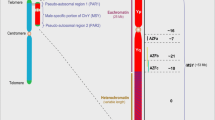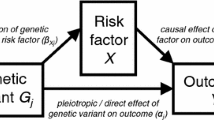Abstract
Studies have shown that many complex diseases are sex-determined. When conducting genetic association studies on X-chromosome, there are two important epigenetic factors which should be considered simultaneously: X-chromosome inactivation and genomic imprinting. Currently, there have been several association tests accounting for the information on X-chromosome inactivation. However, these tests do not take the imprinting effects into account. In this paper, we propose a novel association test simultaneously incorporating X-chromosome inactivation and imprinting effects based on case–parent trios and control–parent trios for female offspring and case–control data for male offspring, denoted by \( MLR_{XCII} \). Extensive simulation studies are carried out to investigate the type I error rate and the test power of the proposed \( MLR_{XCII} \). Simulation results demonstrate that the proposed test controls the type I error rate well and is more powerful than the existing method when imprinting effects exist. The proposed \( MLR_{XCII} \) test is valid and powerful in genetic association studies on X-chromosome for qualitative traits and thus is recommended in practice.




Similar content being viewed by others
References
Amos-Landgraf J. M., Cottle A., Plenge R. M., Friez M., Schwartz C. E., Longshore J. et al. 2006 X chromosome-inactivation patterns of 1005 phenotypically unaffected females. Am. J. Hum. Genet. 79, 493–499.
Avner P. and Heard E. 2001 X-chromosome inactivation: counting, choice and initiation. Nat. Rev. Genet. 2, 59–67.
Bartolomei M. S. 2009 Genomic imprinting: employing and avoiding epigenetic processes. Gene Dev. 23, 2124–2133.
Breslau N., Davis G. C., Andreski P., Peterson E. L. and Schultz L. R. 1997 Sex differences in posttraumatic stress disorder. Arch. Gen. Psychiatry 54, 1044–1048.
Carrel L. and Willard H. F. 2005 X-inactivation profile reveals extensive variability in X-linked gene expression in females. Nature 434, 400–404.
Clayton D. 2008 Testing for association on the X chromosome. Biostatistics 9, 593–600.
Cohn B. A., Wingard D. L., Cirillo P. M., Cohen R. D., Reynolds P. and Kaplan G. A. 1996 Re: Differences in lung cancer risk between men and women: examination of the evidence. J. Natl. Cancer Inst. 88, 1867.
Constância M., Pickard B., Kelsey G. and Reik W. 1998 Imprinting mechanisms. Genome Res. 8, 881–900.
Deng H. W. and Chen W. M. 2001 The power of the transmission disequilibrium test (TDT) with both case-parent and control-parent trios. Genet. Res. 78, 289–302.
Deng X., Berletch J. B., Nguyen D. K. and Disteche C. M. 2014 X chromosome regulation: diverse patterns in development, tissues and disease. Nat. Rev. Genet. 15, 367–378.
Ferguson-Smith A. C. 2011 Genomic imprinting: the emergence of an epigenetic paradigm. Nat. Rev. Genet. 12, 565–575.
Gao F., Chang D., Biddanda A., Ma L., Guo Y., Zhou Z. et al. 2015 XWAS: a software toolset for genetic data analysis and association studies of the X chromosome. J. Hered. 106, 666–671.
Hankin B. L. and Abramson L. Y. 2001 Development of gender differences in depression: an elaborated cognitive vulnerability–transactional stress theory. Psychol. Bull. 127, 773–796.
Hickey P. F. and Bahlo M. 2011 X chromosome association testing in genome wide association studies. Genet. Epidemiol. 35, 664–670.
Hindorff L. A., Sethupathy P., Junkins H. A., Ramos E. M., Mehta J. P., Collins F. S. et al. 2009 Potential etiologic and functional implications of genome-wide association loci for human diseases and traits. Proc. Natl. Acad. Sci. USA 106, 9362–9367.
Kay G. F. 1998 Xist and X chromosome inactivation. Mol. Cell. Endocrinol. 140, 71–76.
Kukurba K. R., Parsana P., Balliu B., Smith K. S., Zappala Z., Knowles D. A. et al. 2016 Impact of the X chromosome and sex on regulatory variation. Genome Res. 26, 768–777.
Lee J. T. 2000 Disruption of imprinted X inactivation by parent-of-origin effects at Tsix. Cell 103, 17–27.
Lee J. T. and Bartolomei M. S. 2013 X-inactivation, imprinting, and long noncoding RNAs in health and disease. Cell 152, 1308–1323.
Lerner D. J. and Kannel W. B. 1986 Patterns of coronary heart disease morbidity and mortality in the sexes: a 26-year follow-up of the Framingham population. Am. Heart J. 111, 383–390.
Li M., Li J., He Z., Lu Q., Witte J. S., Macleod S. L. et al. 2016 Testing allele transmission of an SNP set using a family based generalized genetic random field method. Genet. Epidemiol. 40, 341–351.
Loesch D. Z., Bui Q. M., Kelso W., Huggins R. M., Slater H., Warne G. et al. 2005 Effect of Turner’s syndrome and X-linked imprinting on cognitive status: analysis based on pedigree data. Brain Dev. 27, 494–503.
Lyon M. F. 1962 Sex chromatin and gene action in the mammalian X-chromosome. Am. J. Hum. Genet. 14, 135–148.
Lyon M. F. 1972 X-chromosome inactivation and developmental patterns in mammals. Biol. Rev. 47, 1–35.
Mendelsohn M. E. and Karas R. H. 2005 Molecular and cellular basis of cardiovascular gender differences. Science 308, 1583–1587.
Migeon B. R., Chowdhury A. K., Dunston J. A. and Mcintosh I. 2001 Identification of TSIX, encoding an RNA antisense to human XIST, reveals differences from its murine counterpart: implications for X inactivation. Am. J. Hum. Genet. 69, 951–960.
Minks J., Robinson W. P. and Brown C. J. 2008 A skewed view of X chromosome inactivation. J. Clin. Invest. 118, 20–23.
Naugler W. E., Sakurai T., Kim S., Maeda S., Kim K., Elsharkawy A. M. et al. 2007 Gender disparity in liver cancer due to sex differences in MyD88-dependent IL-6 production. Science 317, 121–124.
Patten M. M., Ross L., Curley J. P., Queller D. C., Bonduriansky R. and Wolf J. B. 2014 The evolution of genomic imprinting: theories, predictions and empirical tests. Heredity 113, 119–128.
Pearson T. A. and Manolio T. A. 2008 How to interpret a genome-wide association study. J. Am. Med. Assoc. 299, 1335–1344.
Penny G. D., Kay G. F., Sheardown S. A., Rastan S. and Brockdorff N. 1996 Requirement for Xist in X chromosome inactivation. Nature 379, 131–137.
Reik W. and Walter J. 2001 Genomic imprinting: parental influence on the genome. Nat. Rev. Genet. 2, 21–32.
Tycko B. and Morison I. M. 2002 Physiological functions of imprinted genes. J. Cell. Physiol. 192, 245–258.
Voskuhl R. 2011 Sex differences in autoimmune diseases. Biol. Sex Differ. 2, 1.
Wang J., Yu R. and Shete S. 2014 X-chromosome genetic association test accounting for X inactivation, skewed X-inactivation, and escape from X-inactivation. Genet. Epidemiol. 38, 483–493.
Wang P., Xu S. Q., Wang B. Q., Fung W. K. and Zhou J. Y. 2019 A robust and powerful test for case-control genetic association study on X chromosome. Stat. Methods Med. Res. 28, 3260–3272.
Wang P., Zhang Y., Wang B. Q., Li J. L., Wang Y. X., Pan D. et al. 2019 A statistical measure for the skewness of X chromosome inactivation based on case-control design. BMC Bioinformatics 20, 11.
Wise A. L., Gyi L and Manolio T. A. 2013 eXclusion: toward integrating the X chromosome in genome-wide association analyses. Am. J. Hum. Genet. 92, 643–647.
Wong C. C. Y., Caspi A., Williams B., Houts R., Craig I. W. and Mill J. 2011 A longitudinal twin study of skewed X chromosome-inactivation. PLoS One 6, e17873.
Xu S. Q., Zhang Y., Wang P., Liu W., Wu X. B. and Zhou J. Y. 2018 A statistical measure for the skewness of X chromosome inactivation based on family trios. BMC Genet. 19, 109.
Yang J. and Lin S. 2012 Likelihood approaches for detecting imprinting and maternal effects in family based association studies. Biometrics 68, 477–485.
Zheng G., Joo J., Zhang C. and Geller N. L. 2007 Testing association for markers on the X chromosome. Genet. Epidemiol. 31, 834–843.
Zhou J. Y., You X. P., Yang R. and Fung W. K. 2018 Detection of imprinting effects for qualitative traits on X chromosome based on nuclear families. Stat. Methods Med. Res. 27, 2329–2343.
Acknowledgements
The authors thank the two reviewers for helpful comments that greatly improve the presentation of the paper. This work was supported by the National Natural Science Foundation of China (grant 81773544), the National and Guangzhou University Students’ Innovation and Enterprise Training Project of China (grant 201712121105) and the Hong Kong RGC GRF grant (17302919).
Author information
Authors and Affiliations
Corresponding authors
Additional information
Corresponding editor: H. A. Ranganath
Rights and permissions
About this article
Cite this article
Liu, W., Wang, BQ., Liu-Fu, G. et al. X-chromosome genetic association test incorporating X-chromosome inactivation and imprinting effects. J Genet 98, 99 (2019). https://doi.org/10.1007/s12041-019-1146-6
Received:
Revised:
Accepted:
Published:
DOI: https://doi.org/10.1007/s12041-019-1146-6




